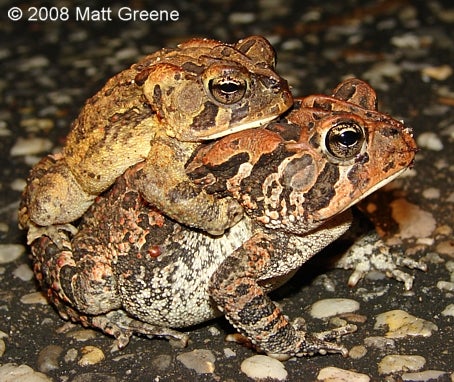SCIENTIFIC NAME:
Anaxyrus terrestris
STATUS:
Common in southern and western portions of Alabama, occupying all of Coastal Plain and western portions of Southwestern Appalachians. Lowest Conservation Concern.
DESCRIPTION:
The southern toad is often brown, but can vary in color from gray, black, and brown with a slight red tint. They are often identified by prominent knob-like extensions located at the rear of the head. Ranges in length from 1.75 to 4 inches and has kidney-shaped parotoid glands.
DISTRIBUTION:
The southern toad is common throughout most of the southeastern portion of the United States. In addition, these toads occupy areas from as far north as southeastern Virginia down the Atlantic coast to Florida. Their range extends as far west as the Mississippi River and enters into eastern Louisiana.
HABITAT:
The southern toad commonly inhabits sandy soil environments. However, these toads have been observed inhabiting marshes, mixed hardwood swamps, agricultural fields, and pine woodlands. Often seen on roads.
FEEDING HABITS:
Capturing its prey with a sticky tongue that projects from the mouth at a high rate of speed, the southern toad will eat small invertebrates, such as beetles, ants, cockroaches, crickets, snails, and anything else that they can swallow.
LIFE HISTORY AND ECOLOGY:
Abundant throughout most of the southeastern United States, the southern toad is commonly seen and heard throughout the warmer months of the year. During the winter months these amphibians exhibit a type of hibernation, referred to as torpor, and remain inactive in their burrows that have been reported to be as deep as 1 foot. During the warmer months the southern toads spend much of their time seeking refuge in their burrows during the day while foraging and mating at night. The breeding season typically ranges from March to September and generally occurs in shallow waters. The eggs are jelly-like and 1/25-1/16 inch in diameter. Over 2500 eggs can be present in the long coil of jelly-like substance. The eggs generally hatch within a 2-4 day period and generally transform from the tadpole stage into frogs approximately 30-55 days later.
Southern toads secrete a bufotoxin from the parotoid glands to make itself distasteful to many of its common predators. Another defense mechanism allows them to inflate their lungs making their body puff up and appear much larger to potential predators.
Although it has always been stated that people can contract warts from touching toads, this is not true. However, the bufotoxin secreted from the parotoid glands can, in some cases, cause some irritation to human mucous membranes.
REFEREMCES:
Blem, C.R. 1963. “Bufo terrestris.” Catalogue of American Amphibians and Reptiles. American Society of Ichthyologists and Herpetologists, 223.1 – 223.4.
Florida Wildlife Extension at UF/IFAS. 2012. “Southern Toad (Bufo terrestris).” (On-line). www.wec.ufl.edu
Wilson, J.D. 2012. “Southern Toad (Bufo terrestris).” (On-line). www.srelherp.uga.edu/anurans/bufter.htm
AUTHOR: Brian Grice, Wildlife Biologist, Alabama Division of Wildlife and Freshwater Fisheries






